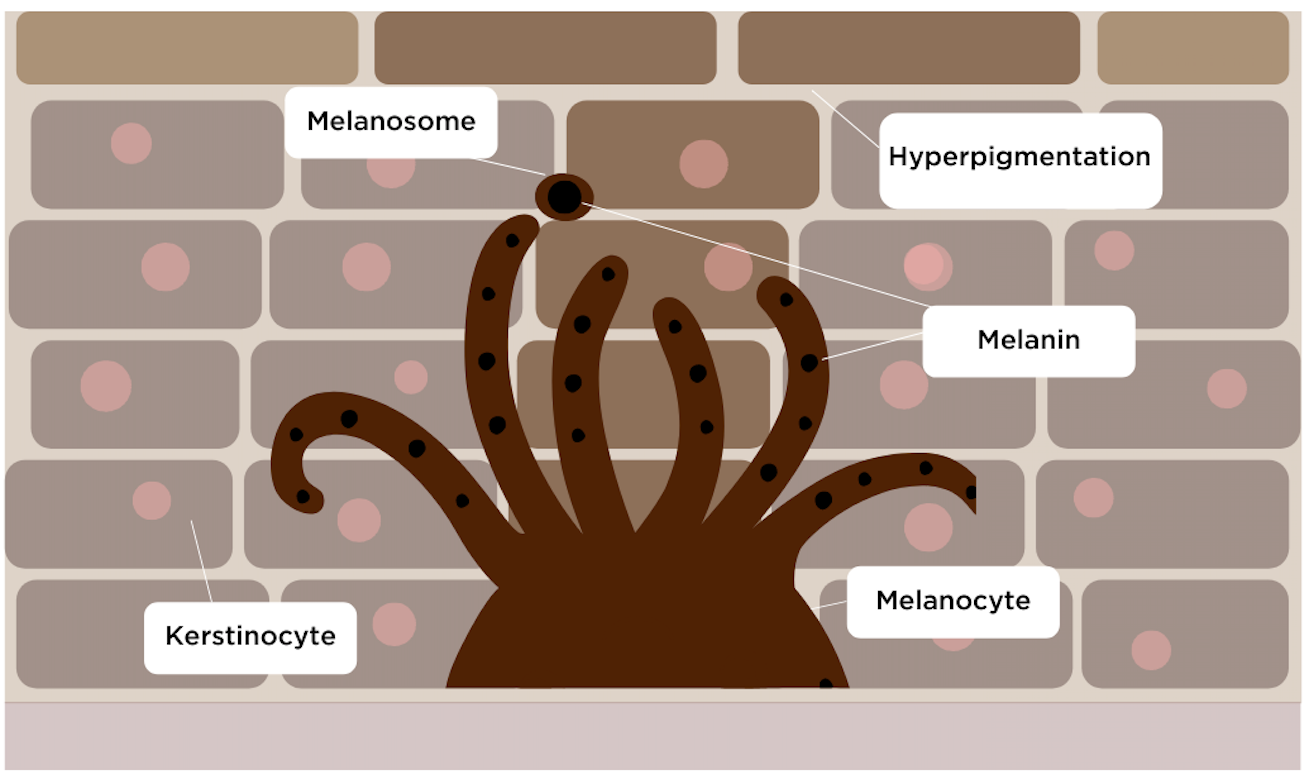
Hyperpigmentation is a medical term used to describe areas of skin that appears darker than the rest of the skin. Hyperpigmentation isn't a medical condition in itself but could be a sign of an underlying medical condition.
Excess melanin production and deposition in the skin will result in patches of skin that is darker than the rest. Hyperpigmentation can be caused by infection/inflammation such as acne or as a result of insults, bites, hormones, genetics, ageing or an underlying medical condition.
Whatever the cause of hyperpigmentation, in Black skin hyperpigmentation can be incredibly stubborn and difficult to treat. Patience is the key. Though pigmentation in the form of freckles is now routinely embraced, the non-uniform darker skin patches can be a source of distress and insecurity for many Brown and Black people.
So, why is hyperpigmentation so difficult to treat in darker skin tones? First, let’s look at some definitions before we get technical.
- Melanin – is a protein that produces pigment in the skin, hair and eyes. It’s the biggest contributor to skin colour and there are two types that exist in the skin (products):
- Eumelanin produces a brown-black pigment and it is abundant in people of African ancestry
- Pheomelanin produces a pink/yellowish pigment and it is more abundant in European ancestry
- Melanocytes – are the cells in the skin that produce both types of melanins in a process called melanogenesis (factory).
- Melanosomes – lie within melanocytes. Melanosomes are the site of melanin production, transportation and deposition (workers).
- Hyperpigmentation is the process of increase melanin deposit in the skin from various causes such as insult, irritation, insect bite, inflammation/infection from various skin conditions and ultraviolet (UV) rays.
The Hyperpigmentation Diagram

What makes hyperpigmentation difficult to treat in skin of colour?
- Hyperpigmentation is more difficult to treat in skin of colour because of three main factors:
- The concentration and type of melanin
- The activity of melanocytes
- The arrangement, type, size and number of melanosomes
Black skin naturally has a higher melanin content and a higher rate of melanin production
Melanocytes in Black skin are more active making more melanin. In fact, Black skin makes five times more melanin than White skin. When hyperpigmentation occurs the melanin production is further increased and deposited in the skin, making it harder to get rid of the excess melanin.
Black skin has a higher eumelanin to pheomelanin ratio
Both White and Black skin produces eumelanin and pheomelanin. However, Black skin produces more than twice the amount of eumelanin than pheomelanin compared to Caucasian skin. This is because eumelanin is very stable, harder to break down and not very easily oxidised. These properties make eumelanin more photostable protecting skin from the harmful UV rays of the sun. Darker-skinned individuals were originally found living near the equator and in hotter climates, thus, eumelanin is an evolutionary protective mechanism against the breakdown of the B vitamin folate and skin cancer. Caucasian ethnic skin types produce more pheomelanin which is less stable therefore more easily broken down, oxidized and susceptible to skin cancer.
The ratio of eumelanin to pheomelanin increases from Caucasian, Asian and African skin resulting in increasingly darkening of the skin through each ethnic skin type, with some skin tone variability in between. This means that Black skin has a higher content of the brown-black eumelanin resulting in darker pigmentation.
Black skin has a greater response to UV exposure
When Black skin is exposed to sunlight the melanocytes react more aggressively by producing more melanin to protect the skin against the harmful rays of sunlight. This is why some darker skin tones tan very easily instead of burning when exposed to intense sunlight.
Melanin is deposited in all five layers of the epidermis in Black skin
The epidermis is the top of three layers of skin (the other two layers are the dermis and hypodermis). Within the epidermis there are five layers, in Black skin melanin is deposited in all five layers, as well as having more melanin dust sprinkled in the outer layer of the epidermis known as the stratum corneum compared to White skin. The stratum corneum is the skin you see, feel and apply your skincare products. In White skin, melanin is deposited in the lower layers of the epidermis with very little in the stratum corneum. The majority of skincare products only manipulate the stratum corneum, making it harder to manage hyperpigmentation since the melanin runs slightly deeper in darker skin compared to Caucasian skin.
Black skin have larger melanosomes
In Black skin the melanosomes are larger and singly dispersed throughout the epidermis, further increasing melanin content and distribution throughout the skin. In White skin, the melanosomes are smaller and aggregated in clusters.
In Black skin the melanin is degraded more slowly
As keratinocytes (skin cells) migrate to the stratum corneum (surface of the skin) from the basal layer (lower layer of the epidermis), melanin in the melanosomes are degraded more slowly in Black skin than in Caucasian skin. Asian skin shows an intermediate amount of melanin degradation between the two ethnicities. Consequently, when hyperpigmentation occurs is takes much longer to fade.
When hyperpigmentation occurs, the melanocytes in Black skin react more aggressively resulting in increased production of eumelanin, from larger melanosomes, distributing more melanin throughout the entire epidermis, combined with slow degradation of melanin makes it very difficult to treat hyperpigmentation in darker skin tones.
Tackling Hyperpigmentation
Decrease melanin content
- Hydroquinone
- Kojic acid
- Azelaic acid
- Licorice
- Arbutin
Increase cell turnover
- Retinoids
- Glycolic acids
- Lactic acids
- Mandelic acids
- Salicylic acids
Decrease eumelanin to pheomelanin ratio
- Cysteine
- Glutathione
Decrease melanosome transfer
- Niacinamide
Antioxidant and protection from UV
- Sunscreens
- Antioxidant
- Vitamin C
- Tocopherol (Vitamin E)
- Resveratrol
